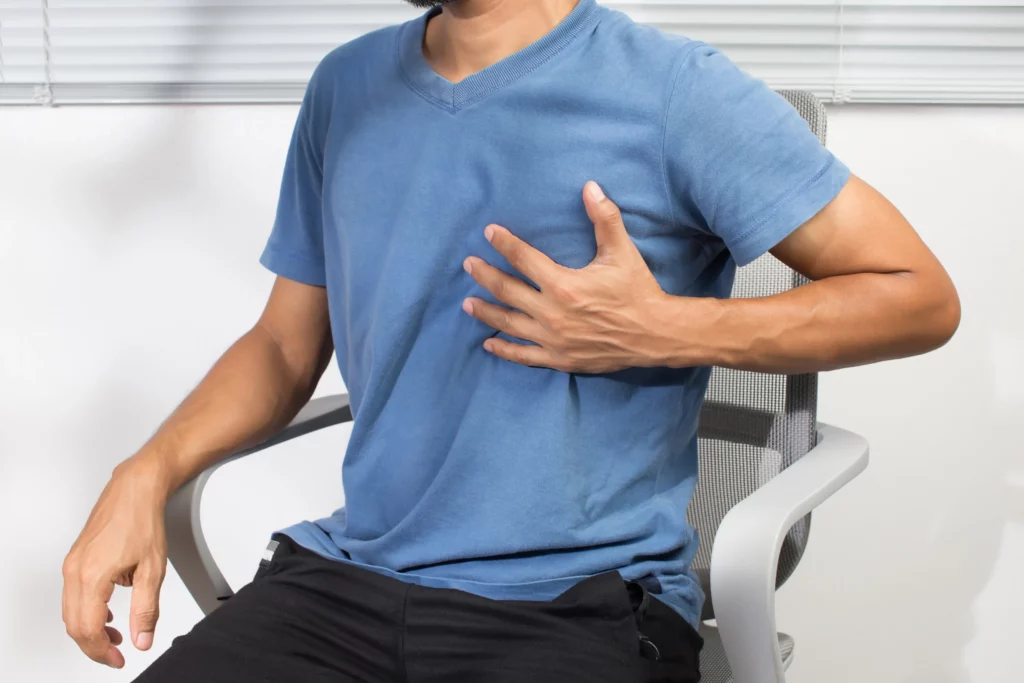In cases of angina, symptoms such as chest pain or discomfort frequently occur as a result of physical exertion or emotional stress.
In general terms, angina happens when there is a reduction in blood flow to the heart. Blood contains oxygen, which is vital for the heart, and when it doesn’t receive enough oxygen, a condition known as ischemia occurs.
Several causes can lead to angina, but the most common is coronary artery disease, a condition in which the arteries that supply blood to the heart become blocked or narrowed due to the buildup of fatty plaque, known as atherosclerosis.
Another possible cause of angina is coronary artery spasms. This action can temporarily reduce blood flow; spasms may be triggered by physical or emotional stress, cold temperatures, or the use of toxic substances.
Other factors that can increase the risk of developing angina are:
- Family history: If first-degree relatives such as parents or siblings have had angina or heart attacks.
- Cholesterol: High cholesterol levels contribute to plaque formation in the arteries.
- Diabetes: High blood glucose levels can damage arteries.
- Age: People over 60 are more likely to develop angina.
- Medications: Some medications can tighten blood vessels.
- Obesity: Excessive weight increases the workload on the heart.
- Other conditions: diabetes, chronic kidney disease, metabolic syndrome, or peripheral artery disease.
- High blood pressure: Over time, hypertension damages and stiffens the arteries.
- Sedentary lifestyle: Little or no physical activity contributes to cardiovascular disease.
- Smoking: Smoking damages arteries and increases the risk of atherosclerosis.
Why Chest Pain Occurs
The characteristic chest pain of angina occurs when the heart muscle, or myocardium, doesn’t get enough oxygen to meet its needs, especially during times of physical or emotional stress.
This lack of oxygen, known as myocardial ischemia, results from a partial blockage or narrowing of the coronary arteries.
Anginal pain is caused by the release of chemical substances—such as adenosine, bradykinin, and protons—that stimulate the nerve endings in the heart.
Chest Pressure
In angina, symptoms like chest pressure are also frequently described. This sensation of pressure, tightness, or heaviness in the center of the chest can last several minutes and is typically felt behind the breastbone (sternum).
Chest pressure is often triggered by physical exertion, cold temperatures, or emotional stress and usually eases with rest or the use of sublingual nitroglycerin.
This symptom should not be underestimated, as it can be an early sign of underlying heart disease.
Types of Angina
Angina is categorized into different types based on its characteristics and causes. The main types include:
- Stable angina: Occurs during physical activity or as a result of emotional stress; these episodes follow a consistent pattern.
- Unstable angina: Can occur with minimal physical effort or even at rest.
- Prinzmetal’s angina (variant angina): Caused by temporary spasms in the coronary arteries.
- Microvascular angina or Syndrome X: Chest pain similar to stable angina, but the coronary arteries are not significantly obstructed.
I Feel Chest Tightness and Have Trouble Breathing
Angina, regardless of its type, indicates that the heart is not receiving enough oxygen from the bloodstream. For this reason, it is essential to monitor this medical condition closely.
The severity of angina varies depending on its type. Stable angina—the most common one—carries moderate risk but can develop into unstable angina, which is more serious and considered a medical emergency as it indicates an imminent risk of heart attack.
In Prinzmetal’s angina, the severity ranges from moderate to severe and, in serious cases, may also lead to a heart attack.
While microvascular angina has a moderate level of severity, it can be debilitating and challenging to diagnose.
In cases of angina, symptoms like persistent or intense pain, left-side chest pain, shortness of breath, excessive sweating, vomiting or nausea, stabbing or pricking sensations in the chest, changes in the pain pattern—especially if intensity or frequency increases—as well as loss of consciousness, are considered serious warning signs.
It is crucial to seek medical attention to receive an accurate diagnosis and proper treatment to help prevent life-threatening complications.
If you experience chest pain, it’s important to understand the cause with the support of a cardiologist.
At ABC Medical Center’s Heart Failure Clinic, we can provide you with specialized care. Contact us!
Fuentes:
MedlinePlus, CardioAlianza, NIH



